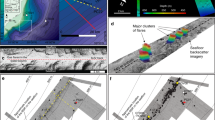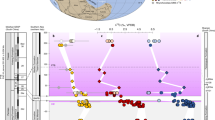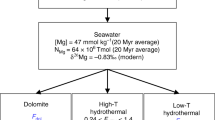Abstract
In the Jurassic period, the Early Toarcian oceanic anoxic event (about 183 million years ago) is associated with exceptionally high rates of organic-carbon burial, high palaeotemperatures and significant mass extinction1,2,3,4. Heavy carbon-isotope compositions in rocks and fossils of this age have been linked to the global burial of organic carbon, which is isotopically light. In contrast, examples of light carbon-isotope values from marine organic matter of Early Toarcian age have been explained principally in terms of localized upwelling of bottom water enriched in 12C versus 13C (refs 1,2,5,6). Here, however, we report carbon-isotope analyses of fossil wood which demonstrate that isotopically light carbon dominated all the upper oceanic, biospheric and atmospheric carbon reservoirs, and that this occurred despite the enhanced burial of organic carbon. We propose that—as has been suggested for the Late Palaeocene thermal maximum, some 55 million years ago7—the observed patterns were produced by voluminous and extremely rapid release of methane from gas hydrate contained in marine continental-margin sediments.
This is a preview of subscription content, access via your institution
Access options
Subscribe to this journal
Receive 51 print issues and online access
$199.00 per year
only $3.90 per issue
Buy this article
- Purchase on Springer Link
- Instant access to full article PDF
Prices may be subject to local taxes which are calculated during checkout



Similar content being viewed by others
References
Jenkyns, H. C. The early Toarcian (Jurassic) anoxic event: stratigraphic, sedimentary and geochemical evidence. Am. J. Sci. 288, 101 –151 (1988).
Jenkyns H. C. & Clayton, C. J. Lower Jurassic epicontinental carbonates and mudstones from England and Wales: chemostratigraphic signals and the early Toarcian anoxic event. Sedimentology 144, 687–706 (1997).
Vakhrameev, V. A. Jurassic and Cretaceous Floras and Climates of the Earth (Cambridge Univ. Press, Cambridge, 1991).
Harries, P. J. & Little, C. T. S. The early Toarcian (Early Jurassic) and the Cenomanian–Turonian (Late Cretaceous) mass extinctions: similarities and contrasts. Palaeogeogr. Palaeoclimatol. Palaeoecol. 154, 39–66 (1999).
Küspert, W. G. in Cyclic and Event Stratification (eds Einsele, G. & Seilacher, A.) 482–501 (Springer, Berlin, Germany, 1982).
Schouten, S., Van Kaam-Peters, H. M. E., Rijpstra, W. I. C., Schoell, M. & Sinninghe Damste, J. S. Effects of an oceanic anoxic event on the stable carbon isotopic composition of Early Toarcian carbon. Am. J. Sci. 300, 1–22, (2000).
Dickens, G. R., O'Neil, J. R., Rea, D. K. & Owen, R. M. Dissociation of oceanic methane hydrate as a cause of the carbon isotope excursion at the end of the Paleocene. Paleoceanography 10, 965–971 (1995).
Duarte, L. V. Clay minerals and geochemical evolution in the Toarcian-lower Aalenian of the lusitanian basin (Portugal). Cuad. Geol. Ibérica 24, 69–98 (1998).
Abbott, G. D., Ewbank, G., Edwards, D. & Guang-Yu, Wang Molecular characterization of some enigmatic Lower Devonian fossils. Geochim. Cosmochim. Acta 62, 1407–1418 ( 1998).
Hallam, A. Estimates of the amount and rate of sea-level change across the Rhaetian–Hettangian and Pliensbachian–Toarcian boundaries (latest Triassic to early Jurassic). J. Geol. Soc. Lond. 154, 773– 779 (1997).
Cope, J. C. W. Discussion on estimates of the amount and rate of sea-level change across the Rhaetian–Hettangian and Pliensbachian–Toarcian boundaries (latest Triassic to Early Jurassic). J. Geol. Soc. Lond. 155, 421 (1998).
Norris, R. D. & Röhl, U. Carbon cycling and chronology of climate warming during the Palaeocene/Eocene transition. Nature 401, 775–778 ( 1999).
Koppelhus, E. B. & Nielsen, L. H. Palynostratigraphy and palaeoenvironments of the lower to middle Jurassic Bagå Formation of Bornholm, Denmark. Palynology 18, 139 –194 (1994).
Howarth, M. K. The ammonite family Hildoceratidae in the Lower Jurassic of Britain. Part 1. Palaeogr. Soc. Monogr. 145, 1– 106 (1992).
Knoll, A. H., Bambach, R. K., Canfield, D. E. & Grotzinger, J. P. Comparative Earth history and Late Permian mass extinction. Science 272, 452–457 ( 1996).
Gröcke, D. R., Hesselbo, S. P. & Jenkyns, H. C. Carbon-isotope composition of Lower Cretaceous fossil wood: Ocean–atmosphere chemistry and relation to sea-level change. Geology 27, 155–158 ( 1999).
Pálfy, J., Parrish, R. R. & Smith, P. L. A U-Pb age from the Toarcian (Lower Jurassic) and its use for time scale calibration through error analysis of biochronologic dating. Earth Planet. Sci. Lett. 146, 659 –675 (1997).
Duncan, R. A., Hooper, P. R., Rehacek, J., Marsh, J. S. & Duncan, A. R. The timing and duration of the Karoo igneous event, southern Gondwana. J. Geophys. Res. 102, 18127–18138 (1997).
Ziegler, P. A. Geological Atlas of Western and Central Europe (Shell Internationale Petroleum, The Hague, 1990).
Hesselbo, S. P. & Jenkyns, H. C. in Mesozoic and Cenozoic Sequence Stratigraphy of European Basins (eds de Graciansky, P. C. et al.) 560–581 (SEPM, Society for Sedimentary Geology, Tulsa, 1998).
Bjerrum, C. J. Numerical Palaeoceanography Of A Jurassic Narrow Meridional Seaway: Transcontinental Currents And Global Ocean Feedbacks. PhD thesis, Univ. Copenhagen (1999).
Shaffer, G. & Bendtsen, J. Role of the Bering Strait in controlling North Atlantic ocean circulation and climate. Nature 367, 354–357 (1994).
Dickens, G. R. Methane oxidation during the Late Palaeocene thermal maximum. Bull. Soc. Géol. Fr. 171, 37– 49 (2000).
Kvenvolden, K. A. in Gas Hydrates: Relevance to World Margin Stability and Climate Change (eds Henriet, J.-P. & Mienert, J.) 9–30 (Geological Society, London, 1998).
Jenkyns, H. C. & Wilson, P. A. Stratigraphy, paleoceanography, and evolution of Cretaceous Pacific Guyots: relics from a Greenhouse Earth. Am. J. Sci. 299, 341 –392 (1999).
Fiet, N. Calibrage temporel de l'Aptien et des sous-étage associés par une approche cyclostratigraphique appliquée à la série pélagique de Marches-Ombrie (Italie centrale). Bull. Soc. Géol. Fr. 171, 103–113 (2000).
Jahren, A. H. & Arens, N. C. Methane hydrate dissociation implicated in Aptian OAE events. Geol. Soc. Am. Abs. Progs 30, 53 (1998).
Smith, A. G., Smith, D. G. & Funnell, B. M. Atlas of Mesozoic and Cenozoic Coastlines (Cambridge Univ. Press, Cambridge, UK, 1994).
Jiménez, A. P., Jiménez de Cisneros, C., Rivas, P. & Vera, J. A. The Early Toarcian anoxic event in the westernmost Tethys (Subbetic): Paleogeographic and paleobiogeographic significance. J. Geol. 104, 399–416 (1996).
Hesselbo, S. P. & Jenkyns, H. C. in Field Geology of the British Jurassic (ed. Taylor, P. D.) 105– 150 (Geological Society, London, 1995).
Acknowledgements
We thank F. Surlyk and G. Pedersen for help with this study. Useful critical comments were provided by J. Hudson. Palaeoceanographic modelling was carried out by C.J.B. in part while at the Geological Institute, University of Copenhagen. Organic carbon-isotope analyses were carried out at the University of Oxford Radiocarbon Unit thanks to T. O'Connell and M. Humm. D.M. Jones and P. Donohoe helped with Py-GC-MS analysis. Scientific discussion with L. Nielsen, G. Henderson and C. Jones is gratefully acknowledged. D.R.G. is funded by ESSO, C.J.B. by the Danish Natural Science Research Council, and H.S.M.B. by a NERC–industrial consortium (Rapid Global Geological Events project).
Author information
Authors and Affiliations
Corresponding author
Rights and permissions
About this article
Cite this article
Hesselbo, S., Gröcke, D., Jenkyns, H. et al. Massive dissociation of gas hydrate during a Jurassic oceanic anoxic event. Nature 406, 392–395 (2000). https://doi.org/10.1038/35019044
Received:
Accepted:
Issue Date:
DOI: https://doi.org/10.1038/35019044
This article is cited by
-
Early Jurassic extrinsic solar system dynamics versus intrinsic Earth processes: Toarcian sedimentation and benthic life in deep-sea contourite drift facies, Cardigan Bay Basin, UK
Progress in Earth and Planetary Science (2024)
-
Orbital pacing and secular evolution of lake-level changes reconstructed by sedimentary noise modeling during the Early Jurassic icehouses-(super)greenhouses
Science China Earth Sciences (2024)
-
Lower Jurassic (Pliensbachian–Toarcian) marine paleoenvironment in Western Europe: sedimentology, geochemistry and organic petrology of the wells Mainzholzen and Wickensen, Hils Syncline, Lower Saxony Basin
International Journal of Earth Sciences (2024)
-
The Toarcian Posidonia Shale at Salem (North Alpine Foreland Basin; South Germany): hydrocarbon potential and paleogeography
International Journal of Earth Sciences (2024)
-
Global ocean redox changes before and during the Toarcian Oceanic Anoxic Event
Nature Communications (2023)
Comments
By submitting a comment you agree to abide by our Terms and Community Guidelines. If you find something abusive or that does not comply with our terms or guidelines please flag it as inappropriate.




